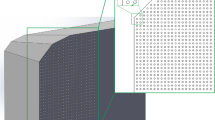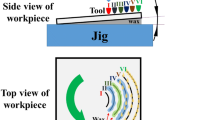Abstract
During machining processes, a high temperature is generated in the cutting zone due to plastic deformation, resulting in an increase of wear and consequently reducing the lifetime of cutting tools. The addition of well-defined patterned surfaces with random or regular microfeatures to cutting tools can improve its wettability, providing an enhanced lubrication effect, a reduced tool-chip friction and a lower tool wear rate. In this sense, this work proposes a laser surface texturing approach of WC-Co green compacts to obtain different cross-hatched micropatterns, for enhancing these tools wettability. Results showed that laser surface texturing allowed to produce well-defined, reproducible and equally spaced cross-hatched micropatterns in WC-Co green compacts. A contact angle of 33.5° was obtained for the experiment with a groove and peak width of 250 μm and 3 laser passages, resulting in a 27% reduction, when compared with an untextured cutting tool (45.8°). This approach was found effective to improve the wettability of WC-Co cutting tools.






Similar content being viewed by others
References
Fernandes CM, Senos AMR (2011) Cemented carbide phase diagrams: a review. Int J Refract Met Hard Mater 29:405–418. https://doi.org/10.1016/j.ijrmhm.2011.02.004
García J, Collado Ciprés V, Blomqvist A, Kaplan B (2019) Cemented carbide microstructures: a review. Int J Refract Met Hard Mater 80:40–68. https://doi.org/10.1016/j.ijrmhm.2018.12.004
Chang SH, Chen SL (2014) Characterization and properties of sintered WC-Co and WC-Ni-Fe hard metal alloys. J Alloys Compd 585:407–413. https://doi.org/10.1016/j.jallcom.2013.09.188
Trent EM, Wright PK (2000) Cutting tool materials II: cemented carbides. In: Metal Cutting, 4th edn. Butterworth-Heinemann, pp 175–226
Upadhyaya G (2002) Materials science of cemented carbides—an overview. Mater Des 22:483–489. https://doi.org/10.1016/s0261-3069(01)00007-3
Abukhshim NA, Mativenga PT, Sheikh MA (2006) Heat generation and temperature prediction in metal cutting: a review and implications for high speed machining. Int J Mach Tools Manuf 46:782–800. https://doi.org/10.1016/j.ijmachtools.2005.07.024
Kara F, Aslantaş K, Çiçek A (2016) Prediction of cutting temperature in orthogonal machining of AISI 316L using artificial neural network. Appl Soft Comput J 38:64–74. https://doi.org/10.1016/j.asoc.2015.09.034
Grzesik W (2017) Heat in metal cutting. In: Grzesik W (ed) Advanced machining processes of metallic materials. Elsevier, pp 163–182
Trent EM, Wright PK (2000) Heat in metal cutting. In: Metal cutting, 4th edn. Butterworth-Heinemann, pp 97–131
Norouzifard V, Hamedi M (2014) A three-dimensional heat conduction inverse procedure to investigate tool–chip thermal interaction in machining process. Int J Adv Manuf Technol 74:1637–1648. https://doi.org/10.1007/s00170-014-6119-6
Carvalho SR, Lima e Silva SMM, Machado AR, Guimarães G (2006) Temperature determination at the chip-tool interface using an inverse thermal model considering the tool and tool holder. J Mater Process Technol 179:97–104. https://doi.org/10.1016/j.jmatprotec.2006.03.086
Sakkaki M, Sadegh Moghanlou F, Vajdi M, Pishgar FZ, Shokouhimehr M, Shahedi Asl M (2019) The effect of thermal contact resistance on the temperature distribution in a WC made cutting tool. Ceram Int 45:22196–22202. https://doi.org/10.1016/j.ceramint.2019.07.241
Pervaiz S, Deiab I, Moustafa E et al (2014) A coupled FE and CFD approach to predict the cutting tool temperature profile in machining. Procedia CIRP 17:750–754. https://doi.org/10.1016/j.procir.2014.01.104
Öztürk B, Kara F (2020) Calculation and estimation of surface roughness and energy consumption in milling of 6061 alloy. Adv Mater Sci Eng 2020:1–12. https://doi.org/10.1155/2020/5687951
Kara F, Aslantas K, Çiçek A (2014) ANN and multiple regression method-based modelling of cutting forces in orthogonal machining of AISI 316L stainless steel. Neural Comput Appl 26:237–250. https://doi.org/10.1007/s00521-014-1721-y
Möhring HC, Kushner V, Storchak M, Stehle T (2018) Temperature calculation in cutting zones. CIRP Ann 67:61–64. https://doi.org/10.1016/j.cirp.2018.03.009
Kara F, Takmaz A (2019) Optimization of cryogenic treatment effects on the surface roughness of cutting tools. Mater Test 61:1101–1104. https://doi.org/10.3139/120.111427
Bruzzone AAG, Costa HL, Lonardo PM, Lucca DA (2008) Advances in engineered surfaces for functional performance. CIRP Ann Manuf Technol 57:750–769. https://doi.org/10.1016/j.cirp.2008.09.003
Sharma V, Pandey PM (2016) Recent advances in turning with textured cutting tools: a review. J Clean Prod 137:701–715. https://doi.org/10.1016/j.jclepro.2016.07.138
Arslan A, Masjuki HH, Kalam MA, Varman M, Mufti RA, Mosarof MH, Khuong LS, Quazi MM (2016) Surface texture manufacturing techniques and tribological effect of surface texturing on cutting tool performance: a review. Crit Rev Solid State Mater Sci 41:447–481. https://doi.org/10.1080/10408436.2016.1186597
Ma J, Duong NH, Chang S, et al (2015) Assessment of microgrooved cutting tool in dry machining of AISI 1045 steel. J Manuf Sci Eng Trans ASME 137. https://doi.org/10.1115/1.4029565
Ribeiro FSF, Lopes JC, Bianchi EC, de Angelo Sanchez LE (2020) Applications of texturization techniques on cutting tools surfaces—a survey. Int J Adv Manuf Technol 109:1117–1135. https://doi.org/10.1007/s00170-020-05669-0
Childs T, Obikawa T, Maekawa K, Yamane Y (2000) Metal machining: theory and applications. Butterworth-Heinemann, London
Chen Y, Wang J, Chen M (2019) Enhancing the machining performance by cutting tool surface modifications: a focused review. Mach Sci Technol 23:477–509. https://doi.org/10.1080/10910344.2019.1575412
Koshy P, Tovey J (2011) Performance of electrical discharge textured cutting tools. CIRP Ann Manuf Technol 60:153–156. https://doi.org/10.1016/j.cirp.2011.03.104
Otitoju TA, Ahmad AL, Ooi BS (2017) Superhydrophilic (superwetting) surfaces: a review on fabrication and application. J Ind Eng Chem 47:19–40. https://doi.org/10.1016/j.jiec.2016.12.016
Wang X, Zheng H, Wan Y, Feng W, Lam YC (2018) Picosecond laser surface texturing of a Stavax steel substrate for wettability control. Engineering 4:816–821. https://doi.org/10.1016/j.eng.2018.10.006
Kubiak KJ, Wilson MCT, Mathia TG, Carval P (2011) Wettability versus roughness of engineering surfaces. Wear 271:523–528. https://doi.org/10.1016/j.wear.2010.03.029
Bormashenko E (2015) Progress in understanding wetting transitions on rough surfaces. Adv Colloid Interf Sci 222:92–103. https://doi.org/10.1016/j.cis.2014.02.009
Allahyari E, Nivas JJ, Oscurato SL et al (2019) Laser surface texturing of copper and variation of the wetting response with the laser pulse fluence. Appl Surf Sci 470:817–824. https://doi.org/10.1016/j.apsusc.2018.11.202
Chryssolouris G, Stavropoulos P, Salonitis K (2013) Process of laser machining. In: Nee A (ed) Handbook of manufacturing engineering and technology. Springer, London, pp 1–25
Etsion I (2005) State of the art in laser surface texturing. J Tribol 127:248–253. https://doi.org/10.1115/1.1828070
Majumdar JD, Manna I (2003) Laser processing of materials. Sadhana 28:495–562. https://doi.org/10.1007/BF02706446
Guimarães B, Fernandes CM, Figueiredo D, Cerqueira MF, Carvalho O, Silva FS, Miranda G (2020) A novel approach to reduce in-service temperature in WC-Co cutting tools. Ceram Int 46:3002–3008. https://doi.org/10.1016/j.ceramint.2019.09.299
Wu Z, Deng J, Xing Y, Cheng H, Zhao J (2012) Effect of surface texturing on friction properties of WC/Co cemented carbide. Mater Des 41:142–149. https://doi.org/10.1016/j.matdes.2012.05.012
Zhang K, Deng J, Xing Y, Li S, Gao H (2015) Effect of microscale texture on cutting performance of WC/Co-based TiAlN coated tools under different lubrication conditions. Appl Surf Sci 326:107–118. https://doi.org/10.1016/J.APSUSC.2014.11.059
Obikawa T, Kamio A, Takaoka H, Osada A (2011) Micro-texture at the coated tool face for high performance cutting. Int J Mach Tools Manuf 51:966–972. https://doi.org/10.1016/j.ijmachtools.2011.08.013
Ze W, Jianxin D, Yang C, Youqiang X, Jun Z (2012) Performance of the self-lubricating textured tools in dry cutting of Ti-6Al-4V. Int J Adv Manuf Technol 62:943–951. https://doi.org/10.1007/s00170-011-3853-x
Lei S, Devarajan S, Chang Z (2009) A study of micropool lubricated cutting tool in machining of mild steel. J Mater Process Technol 209:1612–1620. https://doi.org/10.1016/j.jmatprotec.2008.04.024
Wu Z, Deng J, Su C, Luo C, Xia D (2014) Performance of the micro-texture self-lubricating and pulsating heat pipe self-cooling tools in dry cutting process. Int J Refract Met Hard Mater 45:238–248. https://doi.org/10.1016/j.ijrmhm.2014.02.004
Meng R, Deng J, Liu Y, Duan R, Zhang G (2018) Improving tribological performance of cemented carbides by combining laser surface texturing and W-S-C solid lubricant coating. Int J Refract Met Hard Mater 72:163–171. https://doi.org/10.1016/j.ijrmhm.2017.12.024
Yue H, Deng J, Ge D, Li X, Zhang Y (2019) Effect of surface texturing on tribological performance of sliding guideway under boundary lubrication. J Manuf Process 47:172–182. https://doi.org/10.1016/j.jmapro.2019.09.031
Bertolete M, Barbosa PA, Machado R et al (2018) Effects of texturing the rake surfaces of cemented tungsten carbide tools by ultrashort laser pulses in machining of martensitic stainless steel. Int J Adv Manuf Technol 98:2653–2664. https://doi.org/10.1007/s00170-018-2407-x
Kataria R, Kumar J (2014) Machining of WC-Co composites—a review. Mater Sci Forum 808:51–64. https://doi.org/10.4028/www.scientific.net/msf.808.51
Mahdavinejad RA, Mahdavinejad A (2005) ED machining of WC–Co. J Mater Process Technol 162–163:637–643. https://doi.org/10.1016/J.JMATPROTEC.2005.02.211
Fang S, Herrmann T, Rosenkranz A, Gachot C, Marro FG, Mücklich F, Llanes L, Bähre D (2016) Tribological performance of laser patterned cemented tungsten carbide parts. Procedia CIRP 42:439–443. https://doi.org/10.1016/J.PROCIR.2016.02.228
Guimarães B, Figueiredo D, Fernandes CM, Silva FS, Miranda G, Carvalho O (2019) Laser machining of WC-Co green compacts for cutting tools manufacturing. Int J Refract Met Hard Mater 81:316–324. https://doi.org/10.1016/j.ijrmhm.2019.03.018
Byskov-Nielsen J, Boll JV, Holm AH, Højsholt R, Balling P (2010) Ultra-high-strength micro-mechanical interlocking by injection molding into laser-structured surfaces. Int J Adhes Adhes 30:485–488. https://doi.org/10.1016/j.ijadhadh.2010.03.008
German RM (1994) Powder metallurgy science, 2nd edn. Metal Powder Industries Federation, Princeton
Hao X, Li H, Yang Y, Xiao S, Song X, Li L (2019) Experiment on cutting performance of textured cemented carbide tools with various wettability levels. Int J Adv Manuf Technol 103:757–768. https://doi.org/10.1007/s00170-019-03471-1
Pang M, Liu X, Liu K (2017) Effect of wettability on the friction of a laser-textured cemented carbide surface in dilute cutting fluid. Adv Mech Eng 9:1–9. https://doi.org/10.1177/1687814017738154
Faria D, Madeira S, Buciumeanu M, Silva FS, Carvalho O (2020) Novel laser textured surface designs for improved zirconia implants performance. Mater Sci Eng C 108:110390. https://doi.org/10.1016/j.msec.2019.110390
Acknowledgements
The authors would like to thank PhD Eduardo Silva and PhD Filipe Oliveira from University of Aveiro for helping in the 3D optical profilometry analysis.
Funding
This work was supported by FCT (Fundação para a Ciência e a Tecnologia) through the project POCI-01-0145-FEDER-030353 (SMARTCUT) and also by the project NORTE 01-0145, FEDER-000018 (HAMaBICo). Additionally, this work is supported by FCT with the reference project UID/EEA/04436/2019.
Author information
Authors and Affiliations
Corresponding author
Additional information
Publisher’s note
Springer Nature remains neutral with regard to jurisdictional claims in published maps and institutional affiliations.
Rights and permissions
About this article
Cite this article
Guimarães, B., Fernandes, C.M., Figueiredo, D. et al. Effect of laser surface texturing on the wettability of WC-Co cutting tools. Int J Adv Manuf Technol 111, 1991–1999 (2020). https://doi.org/10.1007/s00170-020-06155-3
Received:
Accepted:
Published:
Issue Date:
DOI: https://doi.org/10.1007/s00170-020-06155-3




